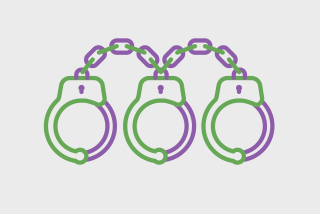No on Proposition 35

- Share via
If reducing sex trafficking and forced labor were as simple as adopting a ballot measure that promised to deal with those predatory practices, there would be every reason to vote for the popular Proposition 35. But the initiative system doesn’t work that way. Voters must ask more than whether they would like to see those cruelties come to an end. They must be satisfied that the particular, far-reaching and inflexible penalties and procedures that would be enacted by this measure would help; that they are the best approach to solving an actual problem; and that actual progress would dwarf any unintended consequences.
Proposition 35 fails those tests. Voters should not be lulled into believing that by approving this measure they will be taking effective action against slavery and sexual exploitation. Even if well intentioned, this initiative falls well short of the mark. The Times urges a no vote.
Voter initiatives can be an important check on a legislature so captured by special interests or partisan politics that it fails to deal with problems as they arise. There is plenty of evidence that California’s Legislature is too timid or cowardly to deal with a variety of problems, but human trafficking is not one of them. The state doesn’t lack for effective laws to combat trafficking. It is among 21 states that have passed significant anti-trafficking legislation. California and federal law today severely punish abduction and pimping of minors (and adults, for that matter), false imprisonment, forced labor and rape. Just last week, Gov. Jerry Brown signed two more important pieces of legislation, including a measure that will make it easier for prosecutors to seize traffickers’ assets.
ENDORSEMENTS: The Times’ recommendations for Nov. 6
These laws were adopted after hearings and testimony, consultation with law enforcement and legal experts, drafting and redrafting. They are designed to take apart the problem systematically and in the context of other criminal laws. Although they deal with separate aspects of the trafficking problem, together they form a comprehensive and — importantly — evolving approach.
Ballot measures, by contrast, are notoriously inflexible, engrafting into law provisions that cannot be changed — without yet another initiative — as drafting flaws come to light, experience provides useful guidance and data pile up to show which practices are effective and which simply make us feel good.
Proposition 35 all too well displays the weaknesses of the ballot process. For example:
VOTER GUIDE: 2012 California Propositions
• It imposes new life terms for some offenders — and would keep them in place even if experience shows no correlation between longer terms and fewer or less egregious offenses. Significantly, proponents present no studies to document or predict such a correlation. As is typical of criminal laws adopted by initiative, this one assumes, foolishly, that criminal minds think, plan and react the same way law-abiding citizens do. California is just now coming to terms with the costly consequences of a generation of long prison sentences adopted only after the state’s crime rates began their historic nose-dive; other states, meanwhile, have been driving down crime by focusing on data and evidence-based policy and sentencing.
• It expands the sex offender registry and, in so doing, converts it from a useful tool to help police and residents track the whereabouts of potentially dangerous sexual predators into a list that includes non-sex criminals, including traffickers who extort money. This muddies the purpose of the database. Traffickers, along with existing sex offenders, would be required to provide local police with their Internet providers and screen names. Few Californians would feel sorry for criminals who have to provide information, but it is a poorly targeted approach to the problem with the registry — the largest in the nation.
• It would change evidence laws to block defendants from raising the sexual history of a victim of human trafficking in a trial, something that is often done to attack the credibility or impeach the character of the victim. That’s a well-intentioned provision, no doubt, but it would most likely face serious constitutional challenges.
Trafficking cases are often hard to prosecute because victims are too scared to step forward. In California, many are undocumented immigrants who don’t speak English; some fear deportation, others distrust police because of experiences in their homelands. And others fear that their captors, who are often part of complex national or transnational crime networks, will retaliate against them or family members back home if they seek help.
The proponents of Proposition 35 ignore that and instead argue that those victims will be more likely to step forward if they believe their captors will be punished harshly. But by that logic, victims would already have an incentive to seek federal help, because federal law imposes harsh penalties, including life terms for the worst offenders. Yet that’s hardly the case.
Sex trafficking of minors is a real problem. There is evidence that in Southern California, gangs that once sold drugs are turning now to forced prostitution, especially of vulnerable girls (and sometimes boys) in foster care. Effectively targeting the problem requires carefully crafted and thoughtful laws that keep pace with the constantly changing practices in the shadowy world of human exploitation. Proposition 35 is not equal to the task.
More to Read
A cure for the common opinion
Get thought-provoking perspectives with our weekly newsletter.
You may occasionally receive promotional content from the Los Angeles Times.










